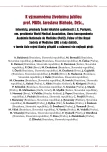-
Medical journals
- Career
The principles of care for patients with intermittent claudication
Authors: K. Roztočil
Authors‘ workplace: Klinika transplantační a cévní chirurgie IKEM Praha, přednosta prof. MUDr. Miloš Adamec, CSc.
Published in: Vnitř Lék 2010; 56(7): 724-726
Category: 80th Birthday - Jaroslava Blahoše, MD, DrSc.
Overview
Patients with claudication have a high cardiovascular risk and, foremost, require an introduction of the appropriate procedures to stop the progression of the disease and to prevent cardiovascular events as if these were patients with a coronary or cerebrovascular disease. To manage the claudication-associated complaints, surgery and endovascular revascularization procedures, exercise therapy and vasoactive agents with proven clinical efficacy are used.
Key words:
atherosclerosis – intermittent claudication – endovascular revascularization – vasoactive treatment
Sources
1. Goodney PP, Beck AW, Nagle J et al. National trends in lower extremity bypass surgery, endovascular interventions, and major amputations. J Vasc Surg 2009; 50 : 54–60.
2. Norgren L, Hiatt WR, Dormandy JA et al. Inter-Society Consensus for the Management of Peripheral Arterial Disease (TASC II). Eur J Vasc Endovasc Surg 2007; 33 (Suppl 1): S1–S75.
3. Sobel M, Verhaeghe R. Antithrombotic therapy for peripheral artery occlusive disease. American College of Chest Physicians Evidence-Based Clinical Practice Guidelines (8th Edition). Chest 2008; 133 (Suppl 6): 815S–843S.
4. Consensus of Central European Vascular Forum on Intermittent Claudication. Milano: Adis International 2005 : 1–27.
5. Gardner AW, Montgomery PS, Parker DE. Physical activity is a predictor of all‑cause mortality in patients with intermittent claudication. J Vasc Surg 2008; 47 : 117–122.
6. Katzmarzyk PT, Church TS, Craig CL et al. Sitting time and mortality from all causes, cardiovascular disease, and cancer. Med Sci Sports Exerc 2009; 41 : 998–1005.
7. Diehm C, Darius H. Atherothrombose – Risikopradiktion und stratifizierung, Biomarker, nichtinvasive Diagnostik, multiple Eriegnisse und Therapie. Gefaessmedizin 2007; 3 : 4–28.
8. McDermott MM, Mehta S, Ahn H et al. Atherosclerotic risk factors are less intensively treated in patients with peripheral arterial disease than in patients with coronary artery disease. J Gen Intern Med 1997; 12 : 209–215.
9. D’Souza J, Patel NN, Rocker M et al. Management of cardiovascular risk factors by primary care physicians in patients with peripheral arterial disease. Surgeon 2008; 6 : 144–147.
10. Selvin E, Hirsch AT. Contemporary risk factor control and walking dysfunction in individuals with peripheral arterial disease: NHANES 199–2004. Atherosclerosis 2008; 201 : 425–433.
11. Welten GM, Schouten O, Hoeks SE et al. Long‑term prognosis of patients with peripheral arterial disease: a comparison in patients with coronary artery disease. J Am Coll Cardiol 2008; 51 : 1588–1596.
Labels
Diabetology Endocrinology Internal medicine
Article was published inInternal Medicine

2010 Issue 7-
All articles in this issue
- Hyperlipoproteinaemia and dyslipoproteinaemia II. Therapy: Non-pharmacological and pharmacological approaches
- Chronic pancreatitis and the skeleton
- Necessity of continuous health system development
- ECG markers in patients with hypertrophic cardiomyopathy
- NATO international advanced course on best way of training for mass casualty situations
- Twelve years of continuing medical education in Slovakia
- Pituitary adenomas – where is the treatment heading at the beginning of the 21st century?
- Oxalic acid – important uremic toxin
- The influence of testosterone on cardiovascular disease in men
- Current options and principles of pathomorphology-based tumour diagnostics
- Natriuretic peptides in patients with aortic stenosis
- Cardiovascular diseases in rheumatoid arthritis
- The principles of care for patients with intermittent claudication
- Distressful journey for the metabolic syndrome to its position in clinical practice
- Diabetic osteopathy: previously disputed but most likely important ailment
- Will vaccines appear on the scene of oncology in the near future?
- Current options for the treatment of osteoporosis
- Laboratory diagnostics and endocrinology
- Parvovirus B19 infection – the cause of severe anaemia after renal transplantation
- Survival and quality of life in burns
- Biofeedback load technique in the rehabilitation of osteoporotic patients (Biomechanical analysis)
- Femur strength index versus bone mineral density: new findings (Slovak epidemiological etudy)
- Internal Medicine
- Journal archive
- Current issue
- Online only
- About the journal
Most read in this issue- Laboratory diagnostics and endocrinology
- The influence of testosterone on cardiovascular disease in men
- Parvovirus B19 infection – the cause of severe anaemia after renal transplantation
- Chronic pancreatitis and the skeleton
Login#ADS_BOTTOM_SCRIPTS#Forgotten passwordEnter the email address that you registered with. We will send you instructions on how to set a new password.
- Career

